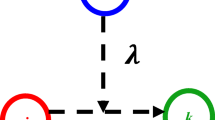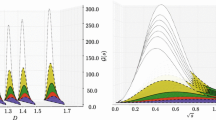Abstract
In our work, we present the nonrelativistic quark model and a new mass formula for study the non-strange baryons octet and decuplet masses. Our model contains a dominant SU(6)-invariant part accounting for the average multiplet energies, and a perturbative SU(6)-violating interaction for the splitting within the multiplets, a structure which is inspired by early Lattice QCD calculations. For our purpose we introduced a spin independent description for SU(6) invariant part of the spectrum, we presented the analytical solution of three particle Schrödinger equation under the suitable phenomenological interaction potential by using the anzast method, through which the average energy values of the nonstrange resonances are reproduced. To describe the hyperfine structure of the baryon and splittings within the SU(6)-multiplets, we used the generalized Gürsey Radicati mass formula. A comparison between our calculations and the experimental data shows that the spectrum of the Roper resonances, the ground states and the excited multiplets up to three GeV are in general well reproduced and comparable with the experimental spectrum. Also one can conclude that; the interaction between the quark constituents of baryon resonances could be described adequately by using the combination of Killingbeck and isotonic oscillator potentials form.
Similar content being viewed by others
References
R. Bijker, F. Iachello, A. Leviatan, Algebraic models of hadron structure. I. Nonstrange baryons. Ann. Phys. 236(1), 69116 (1994)
L.I. Abou-Salem, Study of baryon spectroscopy using a new potential form. Adv. High Energ. Phys. 2014, 5 (2014)
N. Salehi, H. Hassanabadi, A.A. Rajabi, The light and strange baryon spectrum in a non-relativistic hypercentral quark potential model and algebraic framework. Eur. Phys. J. Plus 128, 1–9 (2013)
M.M. Giannini, E. Santopinto, The hypercentral constituent quark model and its application to baryon properties. Chin. J. Phys. 53, 020301 (2015)
Zaim, S., Guelmamene, H., Bahache, A.: 2D schrodinger equation with mixed potential in noncommutaive complex space. http://arxiv.org/abs/1410.0399v1
D. Agboola, J. Links, I. Marquette, Y.-Z. Zhang, New quasi-exactly solvable class of generalized isotonic oscillators. J. Phys. A Math. Theor. 47, 395305 (2014)
M. Znojil, The generalized continued fractions and potentials of the Lennard–Jones type. J. Math. Phys. 31(8), 19551961 (1990)
N. Salehi, H. Hassanabadi, Spectrum of light and strange baryon resonances under the decatic potential. Int. J. Mod. Phys. E 24, 1550002 (2015)
F. Grsey, L.A. Radicati, Spin and unitary spin independence of strong interactions. Phys. Rev. Lett. 13, 173175 (1964)
M.M. Giannini, E. Santopinto, A. Vassallo, A new application of the Gürsey and Radicati mass formula. Eur. Phys. J. A 25(2), 241247 (2005)
K.A. Olive, K. Agashe, C. Amsler et al., Review of particle physics. Chin. Phys. C 38(9), 090001 (2014)
Author information
Authors and Affiliations
Corresponding author
Additional information
This article belongs to the Topical Collection “The 23rd European Conference on Few-Body Problems in Physics”.
Rights and permissions
About this article
Cite this article
Salehi, N. A New Approach for Obtaining the Non-Strange Baryons Spectrum in a Phenomenological Interaction Potential. Few-Body Syst 58, 132 (2017). https://doi.org/10.1007/s00601-017-1294-2
Received:
Accepted:
Published:
DOI: https://doi.org/10.1007/s00601-017-1294-2




